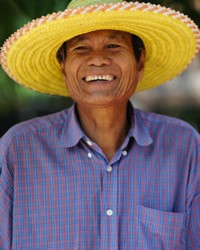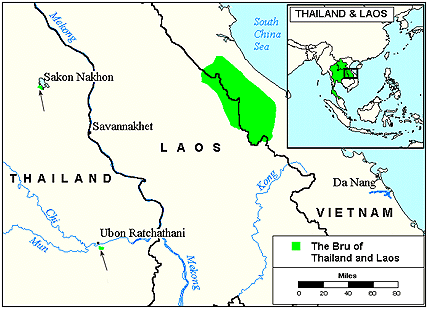The Western Bru in Thailand live along the border with Laos. While they speak the same language (Bru) as the Eastern Bru who live along the border with Vietnam, the dialects are distinct. In fact, dialects can even vary between and within villages. The word "Bru" means "mountain." This name was probably given to the Bru in reference to their geographical location.
The Bru are descendants of the great Khmer Empire that flourished between the ninth and thirteenth centuries and encompassed present-day Thailand, Cambodia, Laos and southern Vietnam. The Empire was eventually conquered by the Thai and Vietnamese. About 400 years ago, the Bru were pushed out of the best valley lands in northern Laos and forced southward by the Thai-speaking peoples.
In recent years, this region has been the location of numerous battles and invasions. It has also become the object of political competition between China, Russia and Vietnam.
Today, most of the Bru are wet-rice farmers. Many have borrowed their agricultural techniques from the Lao, replacing their traditional "slash and burn" method with terrace irrigation. The fields are prepared with plows drawn by buffalo or oxen. Very few farmers use modern equipment. Some of the Bru who live in the mountainous regions or highlands continue to practice "slash and burn" farming. Some also hunt and fish to supplement their incomes. Others have become skilled merchants.
Bru villages are typically located along the banks of rivers or streams. Their houses are usually arranged in a circle, surrounding a central community house. Each home stands on stilts and is divided into several rooms to accommodate extended families. The first room is used to receive guests. It also includes a sacred shrine for spirit worship. Each house contains a fireplace for preparing meals.
Villages are small and self-governing. Each village is under the control of the chao muong, or prince, to whom the commoners pay taxes. The village headman (the eldest male), decides all important issues. Marriages are monogamous and each family is under the leadership of the oldest male.
Virtually all Bru practice ethnic religion. The most important activity is ancestor worship (praying to deceased ancestors for prosperity, guidance and protection). Each clan has a common worship place where they offer uncooked rice, water and broken bowls to the dead. The Bru believe if ancestral spirits are not properly appeased, they will cause illnesses and bad luck. The Bru also worship various spirits in nature and believe each village has a specific "guardian spirit."
Today, the area inhabited by the Bru is peppered with hidden land mines that were dropped by U.S. warplanes during the Vietnam War. Deaths and injuries are common when villagers are working in their fields or gardens. Many children have also been seriously injured while playing in the fields as their parents worked.
The Bru need teams to teach them how to clear the mines. They also need medical help, especially with protheses and physical therapy.
Ask the Lord of the harvest to send laborers into Thailand to live and work among the Bru.
Pray for medical missionaries to share the love of Christ with them.
Ask the Lord to raise up strong local fellowships of believers that will plant more churches.
Pray for a spiritual hunger that will only be satisfied by a relationship with Jesus Christ.
Scripture Prayers for the Bru, Western in Thailand.
https://en.wikipedia.org/wiki/Bru_language
https://www.endangeredlanguages.com/lang/3972/guide
| Profile Source: Joshua Project |











